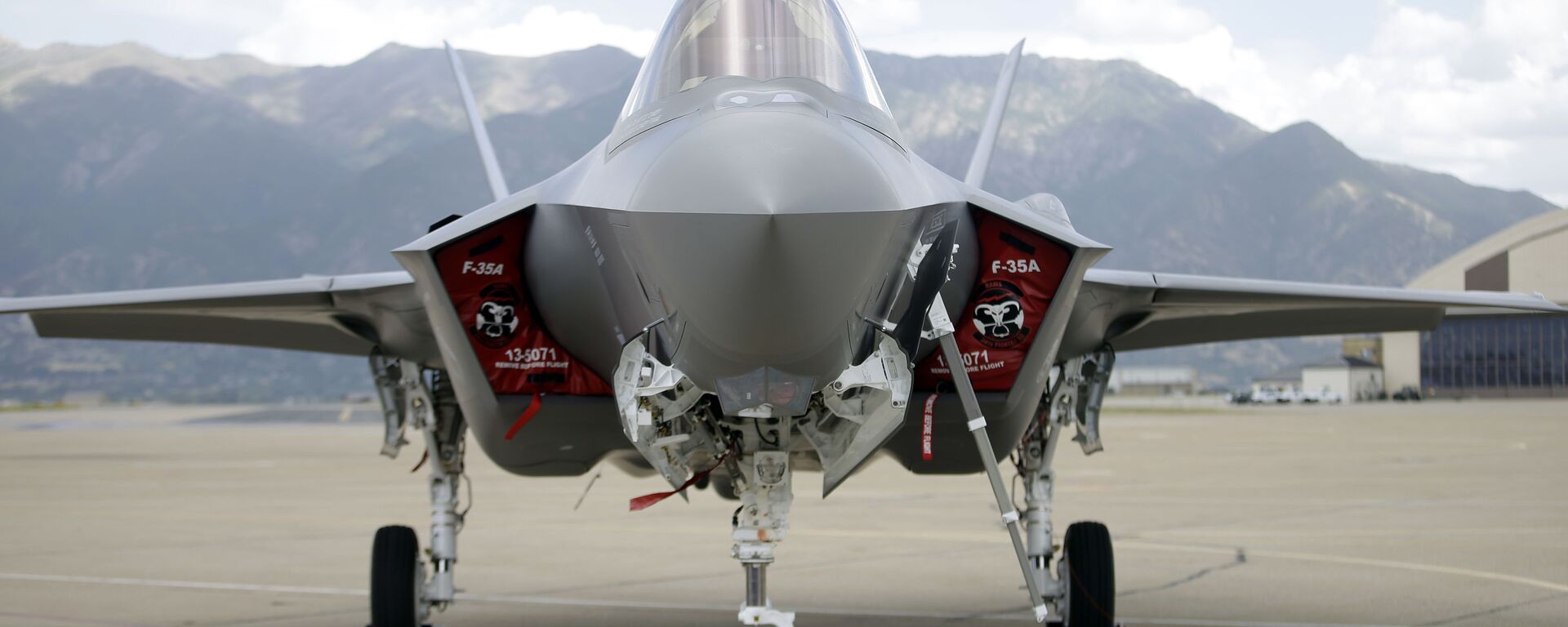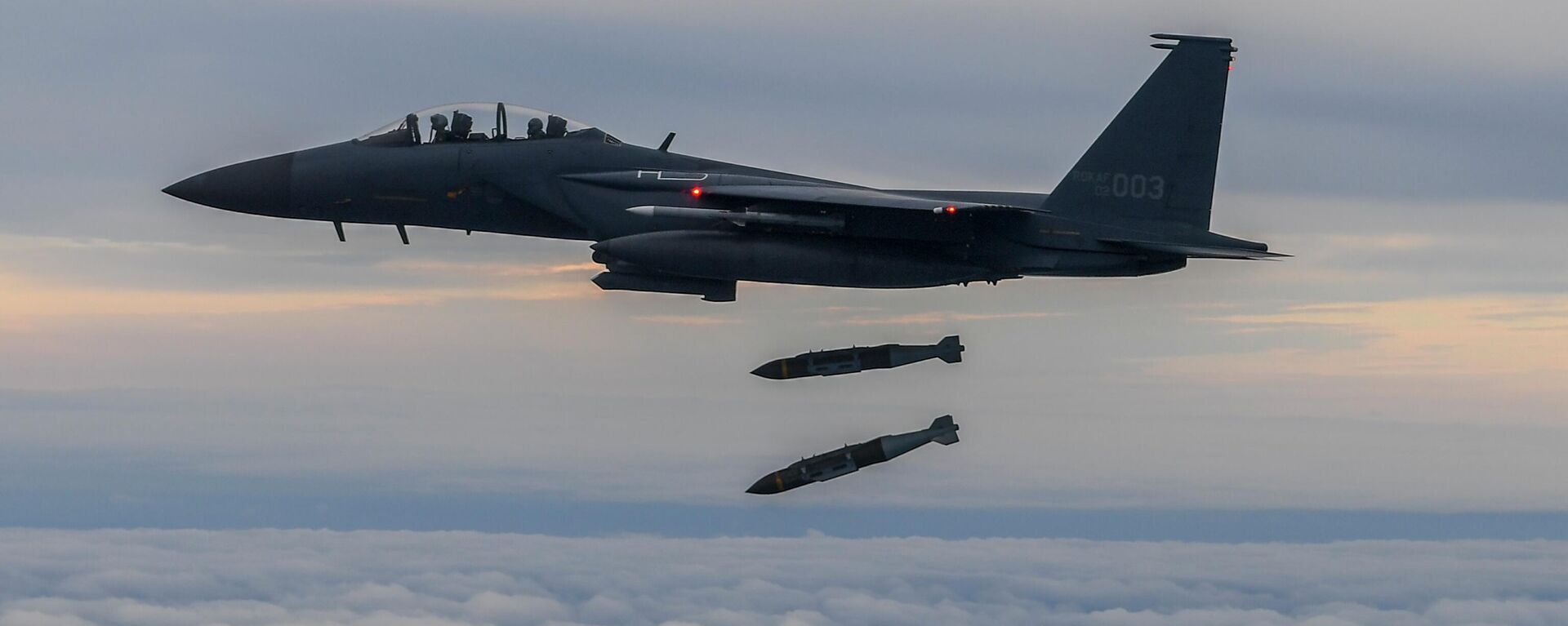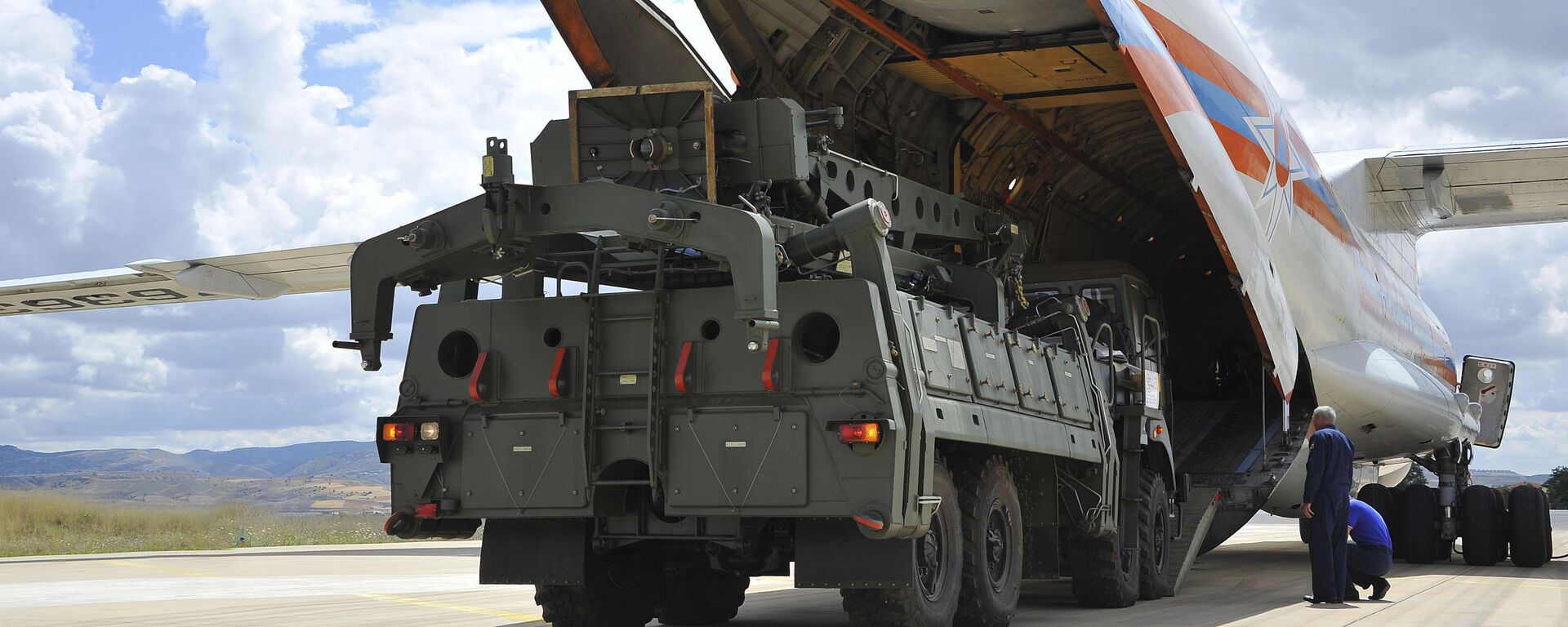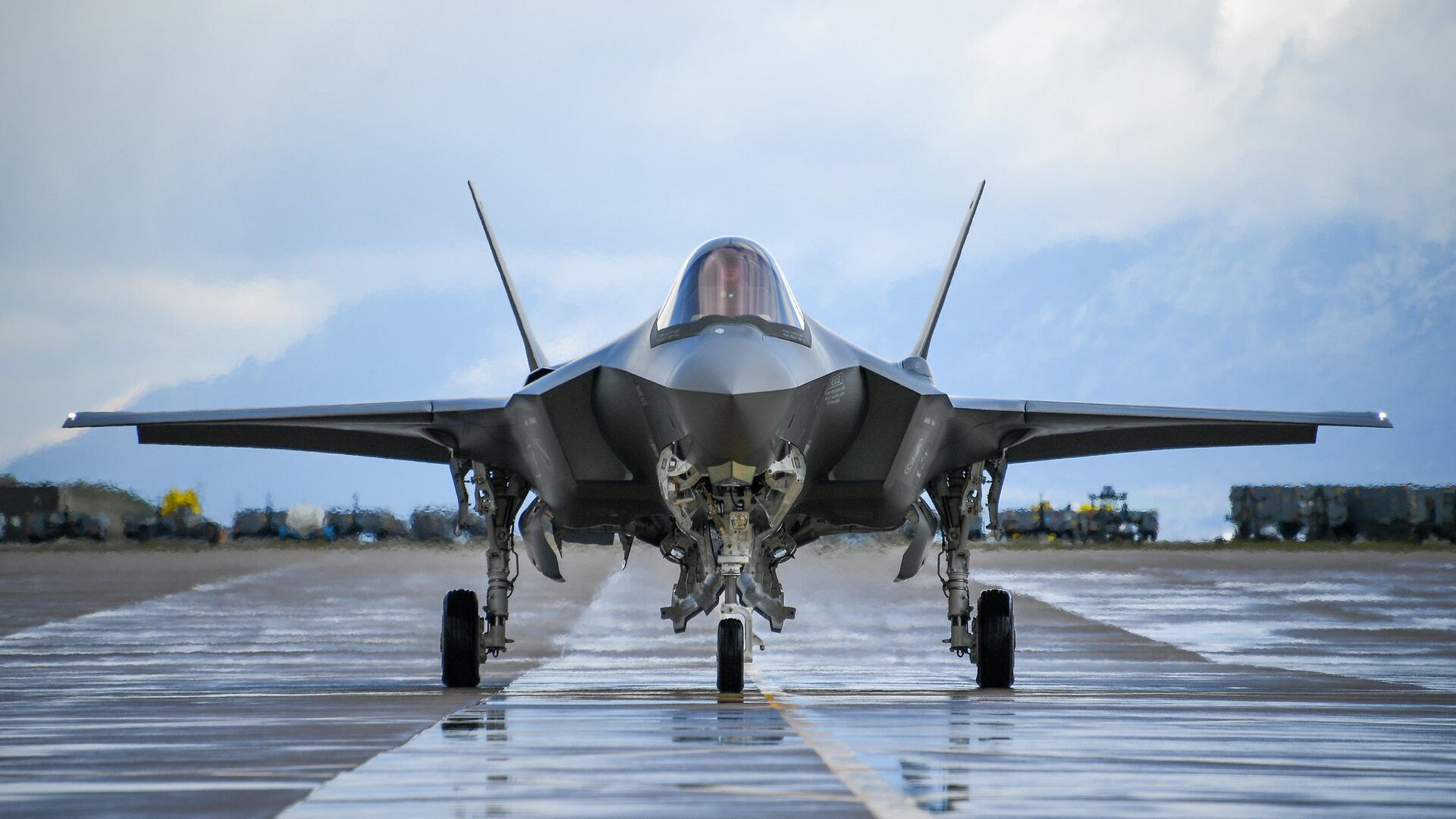https://sputnikglobe.com/20221026/f-35-why-is-it-so-costly-and-whats-wrong-with-it-1102730988.html
F-35: Why Is It So Costly and What's Wrong With It?
F-35: Why Is It So Costly and What's Wrong With It?
Sputnik International
The fifth-generation fighter suffered its latest mishap last week. Why do the pricey planes keep crashing? MIC excess and promises of a ‘jack-of-all trades’ jet have something to with it.
2022-10-26T16:07+0000
2022-10-26T16:07+0000
2022-10-27T14:56+0000
military
f-35
lockheed martin
crash
accident
cost
military-industrial complex
f-35 crash
https://cdn1.img.sputnikglobe.com/img/07e5/04/0f/1082639403_0:0:2048:1152_1920x0_80_0_0_34a7497159e931efd00a99752e96af44.jpg
Last week’s crash of an F-35 Lightning II in Utah has cast fresh light on the project, its exorbitant price tag, and uncertain future. With overall costs expected to reach $1.7 trillion over the project's lifetime, US lawmakers have pulled their hair out trying to get spending under control.What is the F-35 Program?The F-35 is the brainchild of engineers at Lockheed Martin, a behemoth defense contractor enjoying the status of the largest defense company in the US military-industrial complex. Lockheed began development of the F-35 in the mid-1990s after a fierce acquisition competition with Boeing. The Pentagon asked the companies to present their ideas for a "Joint Strike Fighter," an ambitious, all-in-one fifth-generation jet design meant to replace virtually all of America’s fourth-generation fighter, strike, and ground attack aircraft, including the F-16 Falcon, the F/A-18 Hornet and Super Hornet, the AV-8B Harrier II, and others.In the afterglow of the Cold War and at a time when US defense budgets were reaching their post-WWII historic low points, it was assumed that combining the functions of multiple aircraft into a single unified design would give the United States and allies substantial cost savings. That assumption turned out to be disastrously wrong, but more on that later.What are the Plane’s Characteristics?As per the course for fifth-gen aircraft, the F-35 boasts a number of advanced features, first and foremost its stealth characteristics, which are meant to enable it to slip into dense enemy air defenses, drop its payload, shoot down enemy aircraft, and slip out unnoticed. The aircraft has a reported frontal radar cross section of just 0.005m2 – roughly the size of a golf ball.Contrary to statements made by former President Donald Trump, the F-35’s low radar cross section doesn’t make it “invisible,” merely harder to detect at long ranges, and to distinguish from background noise in a crowded aerial environment. The fighter has not been tested in a real life combat situation against advanced air defenses such as Russia’s S-400, Iran’s Bavar-373, or China’s HQ-22, making all estimates on its effectiveness debatable. However, both Western and Russian defense observers have assured that Russia’s next-gen S-500 Prometheus missile system, and possibly even the S-400, have the capability to close the skies to F-35s.The F-35’s onboard Pratt & Whitney F135 fighter engine enables the jet to accelerate to speeds up to Mach 1.6 (1,960 km per hour), and fly up to 2,170 km without refueling. The jet has mid-air refueling capability.F-35s can be fitted with more than 8,150 kg of armaments, including an array of Air Force-standard air-to-surface missiles and glide bombs, air-to-air missiles, and long-range standoff glide and cruise weapons designed to be launched at ranges beyond those of most air defenses. Lockheed’s engineers are also wrapping up work on a B61-12 thermonuclear bomb that can be carried by the jet.How Many F-35 Variants Are There?Because of its advertised role as a multipurpose tool usable by all branches of the US military and America’s foreign allies, the F-35 comes in three different variants. These are the F-35A, designed to operate from conventional runways, the F-35B, capable of vertical take-off and landing (VTOL) flight, and the F-35C, designed for the Navy to operate from carriers at sea. The F-35A is flown by the Air Force and is the default option for foreign sales, with the Marine Corps flying the F-35B, and small numbers also sold to Italy and the UK. The US Navy is the the F-35C's sole user.Who Builds the F-35?Lockheed Martin is the jet's primary contractor, but over 1,900 other manufacturers in the US and a dozen other countries are involved in sourcing each plane’s estimated 50,000 parts.Why Do F-35s Crash?The F-35 was delivered to the Marine Corps in 2015. The Air Force and Navy followed up with their A and C variants in 2016 and 2019, respectively, and the planes have subsequently been sold to other countries. Eight F-35s have gone down between September 2018 and October 2022.Accidents have been attributed to a variety of factors, from faulty nose landing gear to defective engine fuel tubes, the ingestion of foreign objects into the air intake, and pilot error.Given the long list of hardware issues, software glitches, design problems, and parts availability issues, it is perhaps surprising that more of the costly planes have not been lost. Ominous reports over the years by the US Operational Test and Evaluation Office and the congressional Government Accountability Office (GAO) have warned of hundreds of major and minor issues. These have included mission-critical faults like defective helmet-mounted display terminals, ejector seat problems threatening to snap pilots’ necks during flight, faulty oxygen supply systems and fragile aerial refueling probes, vulnerability to lightning, and power and thermal management issues with the planes' engines.The decision to make the F-35 a single-engine aircraft is another issue, since it means that if the engine suffers a major malfunction at sea, or is damaged in enemy territory, it could become nearly impossible for the jet to safely limp back to base.This spring, US lawmakers grilled defense contractors over the jet’s engine design, pointing to a GAO report mentioning “engine issues” as being “a leading driver of the F-35 not being mission capable.”Where Have F-35s Crashed?Six of the eight reported crashes of the F-35 were operated by the US military, with the first going down in September 2018 at Elgin Air Force Base in Florida. The second crashed later the same month outside Marine Corps Air Station Beaufort in South Carolina. The next F-35 crashed in April 2019 off Honshu, Japan, killing its pilot. Another F-35 went down at Elgin in May 2020. In October 2020, a Marine F-35B crashed near Naval Air Facility El Centro, California after slamming into a US KC-130J transport-tanker. After a yearlong break, a British F-35 crashed in the Mediterranean Sea after being launched from the HMS Queen Elizabeth aircraft carrier. Another US F-35 was destroyed in January 2022 after a landing mishap on board the USS Carl Vinson aircraft carrier during a patrol in the South China Sea. Finally, as mentioned above, one more F-35 went down in Utah earlier this month.How Much Does a Single F-35 Cost?The price of a single F-35s depends on its configuration, with a single F-35A costing $79.2 million, while an F-35B goes for $101.3 million, and the F-35C running the Navy $94.4 million apiece. The jets have a per-flight hour cost of about $34,000, about the same as the average after-tax yearly salary in the United States.How Much is the F-35 Program Projected to Cost?The F-35 is the most expensive military procurement program in history, and is expected to cost over $1.7 trillion over its lifetime (including $412 billion for US procurement and $1.3 trillion for maintenance and operations). The Ford-class aircraft carrier, the second-most expensive weapons program in history, is paltry by comparison, costing "just" $38 billion, including $13 billion for the warship itself.The Pentagon’s tolerance for the F-35’s incredible price tag is based around the sunk cost fallacy – the idea that because an exorbitant amount of money has already been spent on a project, one must "stay the course" and see the program through to the end. That philosophy has led to a situation in which the fighter jet’s cost is roughly equivalent to the entire annual GDP of Brazil, South Korea, or Australia.How Many F-35s Does the US Have?Notwithstanding the slew of problems mentioned above, Lockheed Martin has churned out F-35s like hotcakes, with more than 840 delivered to date to the US, British, Italian, Israeli, Australian, Danish, Norwegian, Dutch, Japanese, and South Korean militaries. Belgium, Finland, Poland, Singapore, Switzerland, and the United Arab Emirates have F-35s on order.Why Was Turkey Booted Out of the F-35 Program?Turkey’s ejection from the F-35 program is undoubtedly the biggest political scandal associated with the project. Originally listed as a Tier 1 partner, and responsible for the production of over 900 parts for the F-35, Turkey was kicked out of the program in July 2019, after rejecting Washington’s ultimatum to scrap its agreement with Russia on the purchase of S-400 air defense systems.Amid the diplomatic standoff, Ankara offered a series of workarounds, promising to take measures to assure the compatibility of its S-400s with F-35s and even forming a joint commission on the matter with Washington. However, the US side rejected the proposal, and slapped Turkey’s defense sector with sanctions. Behind the scenes, US and NATO officials reportedly fretted that Ankara could use its S-400s to find chinks in the F-35s’ armor, thereby damaging the plane’s reputation among prospective foreign buyers and leading countries to stock up on the Russian air defense systems.
https://sputnikglobe.com/20221020/fifth-generation-warplane-five-incidents-involving-us-f-35-jets-1102459311.html
https://sputnikglobe.com/20221021/crashes-of-us-made-f-35-jets-all-you-need-to-know-1102511677.html
https://sputnikglobe.com/20221007/pentagon-to-restart-f-35-jet-deliveries-after-pause-over-chinese-sourced-part---reports-1101621152.html
https://sputnikglobe.com/20221020/video-f-35-fighter-jet-crashes-at-utahs-hill-air-force-base-pilot-hospitalized-1102435934.html
https://sputnikglobe.com/20220818/russia-begins-supplies-of-second-s-400-regiment-to-turkey-defense-cooperation-agency-1099728481.html
Sputnik International
feedback@sputniknews.com
+74956456601
MIA „Rossiya Segodnya“
2022
News
en_EN
Sputnik International
feedback@sputniknews.com
+74956456601
MIA „Rossiya Segodnya“
Sputnik International
feedback@sputniknews.com
+74956456601
MIA „Rossiya Segodnya“
f-35, f-35 cost, f-35 lifetime cost, f-35 trillion, f-35 variants, f-35 engine, f-35 problems, f-35 vtol, f-35 crash, f-35 price tag
f-35, f-35 cost, f-35 lifetime cost, f-35 trillion, f-35 variants, f-35 engine, f-35 problems, f-35 vtol, f-35 crash, f-35 price tag
Last week’s crash of an F-35 Lightning II in Utah has cast fresh light on the project, its exorbitant price tag, and uncertain future. With overall costs expected to reach $1.7 trillion over the project's lifetime, US lawmakers have pulled their hair out trying to get spending under control.
What is the F-35 Program?
The F-35 is the brainchild of engineers at Lockheed Martin, a behemoth defense contractor enjoying the status of
the largest defense company in the US military-industrial complex. Lockheed began development of the F-35 in the mid-1990s after a fierce acquisition competition with Boeing. The Pentagon asked the companies to present their ideas for a "Joint Strike Fighter," an ambitious, all-in-one fifth-generation jet design meant to replace virtually all of America’s fourth-generation fighter, strike, and ground attack aircraft, including the F-16 Falcon, the F/A-18 Hornet and Super Hornet, the AV-8B Harrier II, and others.
In the afterglow of the Cold War and at a time when US defense budgets were reaching their post-WWII historic low points, it was assumed that combining the functions of multiple aircraft into a single unified design would give the United States and allies substantial cost savings. That assumption turned out to be disastrously wrong, but more on that later.
What are the Plane’s Characteristics?
As per the course for fifth-gen aircraft, the F-35 boasts a number of advanced features, first and foremost its
stealth characteristics, which are meant to enable it to slip into dense enemy air defenses, drop its payload, shoot down enemy aircraft, and slip out unnoticed. The aircraft has a reported frontal radar cross section of
just 0.005m2 – roughly the size of a golf ball.
Contrary to statements made by former President Donald Trump, the F-35’s low radar cross section
doesn’t make it “invisible,” merely harder to detect at long ranges, and to distinguish from background noise in a crowded aerial environment. The fighter has not been tested in a real life combat situation against advanced air defenses such as Russia’s S-400, Iran’s Bavar-373, or China’s HQ-22, making all estimates on its effectiveness debatable. However, both
Western and
Russian defense observers have assured that Russia’s next-gen S-500 Prometheus missile system, and possibly even the S-400, have the capability to close the skies to F-35s.
The F-35’s onboard Pratt & Whitney F135 fighter engine enables the jet to accelerate to speeds up to Mach 1.6 (1,960 km per hour), and fly up to 2,170 km without refueling. The jet has mid-air refueling capability.
F-35s can be fitted with more than 8,150 kg of armaments,
including an array of Air Force-standard air-to-surface missiles and glide bombs, air-to-air missiles, and long-range standoff glide and cruise weapons designed to be launched at ranges beyond those of most air defenses. Lockheed’s engineers are also wrapping up work on a B61-12 thermonuclear bomb that can be carried by the jet.

20 October 2022, 14:04 GMT
How Many F-35 Variants Are There?
Because of its advertised role as a multipurpose tool usable by all branches of the US military and America’s foreign allies, the F-35
comes in three different variants. These are the F-35A, designed to operate from conventional runways, the F-35B, capable of vertical take-off and landing (VTOL) flight, and the F-35C, designed for the Navy to operate from carriers at sea. The F-35A is flown by the Air Force and is the default option for foreign sales, with the Marine Corps flying the F-35B, and small numbers also sold to Italy and the UK. The US Navy is the the F-35C's sole user.
Lockheed Martin is the jet's primary contractor, but
over 1,900 other manufacturers in the US and a dozen other countries are involved in sourcing each plane’s estimated 50,000 parts.
The F-35 was delivered to the Marine Corps in 2015. The Air Force and Navy followed up with their A and C variants in 2016 and 2019, respectively, and the planes have subsequently been sold to other countries. Eight F-35s have gone down between September 2018 and October 2022.
Accidents have been attributed to a variety of factors, from faulty nose landing gear to defective engine fuel tubes, the ingestion of foreign objects into the air intake, and pilot error.
Given the long list of hardware issues, software glitches, design problems, and parts availability issues, it is perhaps surprising that more of the costly planes have not been lost. Ominous reports over the years by the US Operational Test and Evaluation Office and the congressional Government Accountability Office (GAO)
have warned of hundreds of major and minor issues. These have included mission-critical faults like defective helmet-mounted display terminals, ejector seat problems threatening to snap pilots’ necks during flight, faulty oxygen supply systems and fragile aerial refueling probes, vulnerability to lightning, and power and thermal management issues with the planes' engines.
The decision to make the F-35 a single-engine aircraft is another issue, since it means that if the engine suffers a major malfunction at sea, or is damaged in enemy territory, it could become nearly impossible for the jet to safely limp back to base.
This spring, US lawmakers grilled defense contractors over the jet’s engine design, pointing to a GAO report mentioning “engine issues” as being “a leading driver of the F-35 not being mission capable.”
“Maybe the engine is not working, which is a Pratt & Whitney problem. They’re going to be before this committee soon. If they’re in the audience and if they’re listening, watch out. I’m coming at you in a very angry mood. You give us an engine and it doesn’t work, well, it worked for a little while until it gets some dust around it and then it doesn’t work. What the hell? What’s going on here?” a flustered Congressman John Garamendi, chairman of the House Armed Services Subcommittee,
said at a session in late April.

7 October 2022, 20:23 GMT
Where Have F-35s Crashed?
Six of the eight reported crashes of the F-35 were operated by the US military, with the first going down in September 2018 at Elgin Air Force Base in Florida. The second crashed later the same month outside Marine Corps Air Station Beaufort in South Carolina. The next F-35 crashed in April 2019 off Honshu, Japan, killing its pilot. Another F-35 went down at Elgin in May 2020. In October 2020, a Marine F-35B crashed near Naval Air Facility El Centro, California after slamming into a US KC-130J transport-tanker. After a yearlong break, a British F-35 crashed in the Mediterranean Sea after being launched from the HMS Queen Elizabeth aircraft carrier. Another US F-35 was destroyed in January 2022 after a landing mishap on board the USS Carl Vinson aircraft carrier during a patrol in the South China Sea. Finally, as mentioned above, one more F-35 went down in Utah earlier this month.
How Much Does a Single F-35 Cost?
The price of a single F-35s depends on its configuration, with a single F-35A costing $79.2 million, while an F-35B goes for $101.3 million, and the F-35C running the Navy $94.4 million apiece. The jets have a per-flight hour cost of about $34,000, about the same as the average after-tax yearly salary in the United States.
How Much is the F-35 Program Projected to Cost?
The F-35 is the most expensive military procurement program in history, and is expected to cost
over $1.7 trillion over its lifetime (including $412 billion for US procurement and $1.3 trillion for maintenance and operations). The Ford-class aircraft carrier, the second-most expensive weapons program in history, is paltry by comparison, costing "just" $38 billion, including $13 billion for the warship itself.
The Pentagon’s tolerance for the F-35’s incredible price tag is based around the sunk cost fallacy – the idea that because an exorbitant amount of money has already been spent on a project, one must "stay the course" and see the program through to the end. That philosophy has led to a situation in which the fighter jet’s cost is roughly equivalent to the entire annual GDP of Brazil, South Korea, or Australia.

20 October 2022, 02:11 GMT
How Many F-35s Does the US Have?
Notwithstanding the slew of problems mentioned above, Lockheed Martin has churned out F-35s like hotcakes, with
more than 840 delivered to date to the US, British, Italian, Israeli, Australian, Danish, Norwegian, Dutch, Japanese, and South Korean militaries. Belgium, Finland, Poland, Singapore, Switzerland, and the United Arab Emirates have F-35s on order.
Why Was Turkey Booted Out of the F-35 Program?
Turkey’s ejection from the F-35 program is undoubtedly the biggest political scandal associated with the project. Originally listed as a Tier 1 partner, and responsible for the production of over 900 parts for the F-35, Turkey was kicked out of the program in July 2019, after rejecting Washington’s ultimatum to scrap its agreement with Russia on the purchase of S-400 air defense systems.
Amid the diplomatic standoff, Ankara offered a series of workarounds, promising to take measures to assure the compatibility of its S-400s with F-35s and even forming a joint commission on the matter with Washington. However, the US side rejected the proposal, and slapped Turkey’s defense sector with sanctions. Behind the scenes, US and NATO officials
reportedly fretted that Ankara could use its S-400s to find chinks in the F-35s’ armor, thereby damaging the plane’s reputation among prospective foreign buyers and leading countries to stock up on the Russian air defense systems.

18 August 2022, 10:53 GMT







